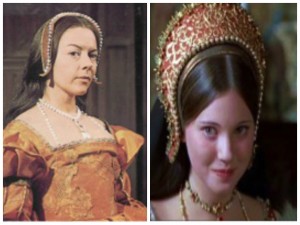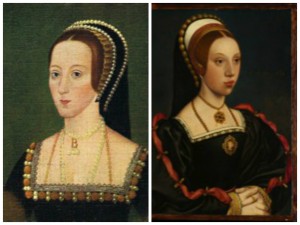I am delighted to welcome Conor Byrne to On the Tudor Trail. Conor is a history student at the University of Exeter whose research interests include gender, cultural and social history. He specialises in the late medieval an early modern periods and is particularly interested in the Tudor court.
The Queens’ Lovers
The men implicated in the downfalls of Queens Anne Boleyn and Katherine Howard
By Conor Byrne
The executions of two of Henry VIII’s consorts, Anne Boleyn and Katherine Howard, in 1536 and 1542 respectively, were unprecedented. Kings had previously annulled royal marriages or, in the case of French kings, rusticated their consorts from court and installed them in convents, but never before had they ended their marriages by executing their wives. Contemporaries expressed a sense of shock at the beheadings of these two women. John Foxe, the martyrologist, contended that a deep mystery surrounded Anne’s downfall, while John Weever, writing in the seventeenth century, related that ‘many strong reasons are given… to confirm that belief, that neither this Queen Katherine [Howard], nor Queen Anne [Boleyn], were any way guilty of the breach of matrimony, whereof they were accused’.
Most modern historians, with the exception of G.W. Bernard, believe that Anne Boleyn was not guilty of the sexual crimes attributed to her in 1536, although they disagree in their explanations for why she died (the various theories encompass a Cromwellian conspiracy; the birth of a deformed son to the queen which indicated witchcraft on her behalf; and the ‘cock-up’ theory advocated by scholars such as Lipscomb and Walker). Although historians continue to believe that Katherine Howard probably conducted at least one adulterous affair during her brief queenship, my research indicates that she was neither an adulteress nor the rampant sexual predator beloved of modern media. This article focuses on the seven men charged with sexual crimes with these two most unfortunate of Henry’s wives, asking whether patterns can be discerned.
Historians who favour the factional conspiracy argument in relation to Anne Boleyn’s downfall, including the late Eric Ives, usually maintain that Cromwell deliberately chose five men – with the exception of the lowborn Mark Smeaton – closely associated with Anne in what has, perhaps anachronistically, been termed ‘the Boleyn faction’ at court. Fearing their power, Cromwell sought to rid himself of them through charging them with sexual offences committed with the queen. The argument goes that this reformed group were united in their hostility to the ‘Aragonese’ camp – i.e. supporters of Katherine of Aragon and her daughter, the former princess Mary – and were driven by their commitment to the reformed faith. That George Boleyn, younger brother of the queen, shared a commitment to reformed religion there is no doubt, but most historians now doubt whether these individuals were comprised in what can be termed a ‘faction’ in the modern sense of the word. Certainly Anne’s interaction with William Brereton and Mark Smeaton was minimal, at best, and whether or not she engaged in flirtation with Henry Norris and Francis Weston, the two other men accused of adultery with her, or whether she instead reprimanded them for their behaviour within the court, is still uncertain.
If these men, then, were not united in a ‘faction’ opposing Cromwell’s interests, allegedly headed by the formidable Queen, then why were they implicated with Anne? One theory favoured by Retha Warnicke is that all five were known to be licentious and were suspected of committing buggery and sodomy, thus making them easy candidates for the paternity of the supposed monstrous baby the Queen had delivered in January 1536. The evidence for this, however, is even more minimal than that supplied for Ives’ factional theory. At best it relies on the men’s scaffold speeches and a book given by George Boleyn to Mark in 1526. Although the men, including Rochford and Weston, referred to their ‘sin’ and ‘abomination’, this does not necessarily refer to same-sex relations. Opposing this argument, G.W. Bernard, who actually believes that Anne was guilty, suggested the obvious answer: that the five men were accused of sexual crimes with the king’s consort because they had actually committed these offences. Historians such as Ives and Warnicke have convincingly dismissed this argument.
Why these men were associated with lecherous offences with Anne can’t now be determined. But one crucial aspect that differentiates Anne’s downfall from that of her cousin Katherine is striking: unlike – as will be discussed – Katherine, it does not appear that Anne was the victim of psychological blackmail from her supposed adulterers. This makes sense given Anne’s age, character, and relationship with the king. The likeliest explanation, which seems to now be favoured by several historians, is that the queen was close, but not unconventionally so, to the men involved in her downfall, with the probable exceptions of both Smeaton and Brereton, and that “pastime in the queen’s chamber” in the spring of 1536 acquired a darker meaning. Lipscomb has compellingly argued that Henry VIII suffered a crisis of masculinity in the first few months of 1536, given his terrifying accident that January followed by his wife’s miscarriage. Perhaps Anne’s speech and actions during the last weekend of April, as Walker suggests, were suspicious, even if she hardly meant for them to be interpreted in the manner in which they were. Lipscomb’s suggestion of a crisis of gender relations at court in 1536 is instructive, in view of the events of 1541-2. Perhaps, both queens were brought down by gender tensions at court.
 In contrast to Anne, Katherine’s youthful past was murkier. When she became queen in 1540, she chose to appoint individuals from her childhood to important positions at court, almost certainly as a misguided means of keeping them quiet about her past. Francis Dereham was one of them. He had forced himself upon the teenage Katherine in 1538-9, perhaps having initially rescued her from another abusive individual, the musician Henry Manox. Once he had arrived at court, Dereham boasted openly about his claims on the queen and even suggested, foolishly, that he would marry her once the ageing king died. Around the same time that Dereham began aggressively manipulating the queen, in the spring of 1541, Thomas Culpeper began entreating Queen Katherine to meet with him privately, assisted by Lady Rochford. Traditionally, Lady Rochford has been implicated in Anne Boleyn’s downfall and is typically characterised as a shrewish and vengeful woman who plotted her husband’s demise by accusing him of incest. Most historians now doubt this fanciful interpretation, for there is no evidence to support it.
In contrast to Anne, Katherine’s youthful past was murkier. When she became queen in 1540, she chose to appoint individuals from her childhood to important positions at court, almost certainly as a misguided means of keeping them quiet about her past. Francis Dereham was one of them. He had forced himself upon the teenage Katherine in 1538-9, perhaps having initially rescued her from another abusive individual, the musician Henry Manox. Once he had arrived at court, Dereham boasted openly about his claims on the queen and even suggested, foolishly, that he would marry her once the ageing king died. Around the same time that Dereham began aggressively manipulating the queen, in the spring of 1541, Thomas Culpeper began entreating Queen Katherine to meet with him privately, assisted by Lady Rochford. Traditionally, Lady Rochford has been implicated in Anne Boleyn’s downfall and is typically characterised as a shrewish and vengeful woman who plotted her husband’s demise by accusing him of incest. Most historians now doubt this fanciful interpretation, for there is no evidence to support it.
My research indicates that Culpeper was not in love with Katherine, and she was not in love with him. He probably began blackmailing both queen and Rochford to meet with Katherine, perhaps because, as Warnicke suggests, he had discovered news of Katherine’s unsavoury past. Certainly, if Dereham was openly bragging about his conquest of the queen, this would make sense. Because of Katherine’s age, – she was about seventeen in 1541 – her naivety and failure to bear the king an heir, she was both politically and personally manipulated in a way in which the older, more experienced Anne Boleyn could never have been. During the summer of 1541, as the court travelled north, Culpeper contrived to meet with the queen several times in dark and remote corners of palaces; mirroring Katherine’s youthful meetings with Manox in hidden, shadowy areas. It appears her abusers consistently endeavoured to meet with her in dark places, away from the company of others. Culpeper perhaps ensured that the queen rewarded him materially and politically in exchange for his silence.
Unsurprisingly, the court soon learned of the queen’s meetings and her former relationship with Dereham. Conforming to early modern expectations of women, they seem to have accepted Katherine as a harlot. The king wept for her and displayed none of the delight he had exhibited during Anne’s last weeks. Perhaps he genuinely believed Katherine was guilty. However he felt, his fifth queen was beheaded in 1542, as was Lady Rochford. Katherine was not the scheming adulteress she has often been depicted as, nor was Lady Rochford the vengeful sociopath who engineered the affairs with Culpeper for mysterious reasons of her own. It is likely that both women were victims of ruthless male predators at court who perceived the queen to be an easy mark, and Rochford because she was the closest woman to the queen, as Lady of her Bedchamber. Blackmail and ambition, not love and desire, encapsulated those fatal meetings in 1541. Clearly, as Weever’s evidence indicates, some contemporaries came to feel doubt concerning Katherine’s guilt.
The men with whom Anne Boleyn was executed with in 1536 might have been close to her, but not in the sense which the two men beheaded alongside Katherine Howard were with her. Whereas Anne had presided over a flirtatious and merry court that viewed courtly love as a pastime, Katherine by contrast, because of her youth and naivety, was unable to maintain a sophisticated distance from male courtiers and was, by virtue of her blemished past, easily manipulated by them once they had knowledge of it. This article, brief as it is, suggests that neither woman was guilty of adultery. Instead, albeit in very different circumstances, they were executed in climates of fear, sexual cuckoldry and gender tensions, bringing down seven men with them.


















That’s an really interesting article. It makes a refreshing change for someone to believe Queen Anne and Queen Kathrine to be innocent of crimes they lost their lifes for.
Interesting article. Certainly sheds a new light and gives a different perspective of it all. I like the pictures by the way one of them is familiar as we all know to be Anne Boleyn but the other is a new image and is just labeled unknown woman but I do believe this to be a likeness of Katheryn Howard. It is cute and the attire is excelling as well as striking.